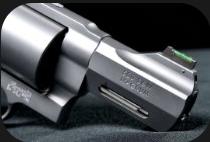
Smith & Wesson Model 500 Is a Monster Gun: On the one hand, Clint Eastwood’s most iconic character – besides The Man With No Name from Sergio Leone’s so-called “spaghetti western trilogy” – San Francisco PD Inspector “Dirty” Harry Callahan, might be slightly disappointed to know that his beloved Smith & Wesson Model 29 .44 Magnum is no longer “the most powerful handgun in the world” (Ed. By the time the film was made, the .44 Remington Magnum cartridge had been eclipsed in size and power by the .454 Casull round). On the other hand, good ol’ Harry might be able to take at least partial solace in the fact that the new claimant to the title comes from the same manufacturer as his S&W M29.
Say hello to the Smith & Wesson Model 500 in the .500 S&W Magnum caliber.
Smith & Wesson Model 500: & Cartridge History & Specifications
If you’re a 1990s sci-fi fan, then you’re familiar with The X-Files. If you were a follower of World Wrestling Entertainment’s (WWE’s) “Attitude Era” in the late 1990s and early 2000s, then you’ll remember the X-Factor. But how many shooters have heard of X-frame revolvers? I must admit that even though (1) I’ve been shooting for 33+ years and (2) I’ve actually already fired an X-frame, I myself wasn’t familiar with the term until today when I started doing research for this very article.
So then, “X-frame” is S&W’s designation for their Extra Large Frame Series; for a basis of comparison and contrast, the aforementioned Model 29, as well as the Model 27 .357 Magnum (the world’s first make and model in that caliber), Model 610 10mm, and Model 57 .41 Magnum, all fall under the mere “N-frame” Large Frame Series. As y’all have probably already guessed by now, the Model 500 falls under the X-frame category.
This behemoth of a blaster made its debut in 2003 (which means the gun will be celebrating its 20th birthday this year). As for the .500 S&W Magnum cartridge it’s chambered for, a May 2003 issue of NRA American Rifleman gives this historical nugget of info:
“Cor-Bon came up with three different loads for the .500 S&W Mag. The first can only be called a remarkable deer or antelope load. At a factory claimed 1665 f.p.s. from the 8 3⁄8”-barreled Model 500, this big number reliably expands fully to around 1” in diameter early in its penetration. Muzzle energy for this, the ‘light’ load of the trio, is around 1,700 ft.-lbs., and at 100 yds. it packs about the same wallop as a 300-gr. .454 Casull … The final load is a little intimidating, even to a seasoned magnum handgunner. I know I approached it with some trepidation. It launches a deep-penetrating 440-gr. flat-nose, hard-cast bullet…that is listed at a bone-smashing 1625 f.p.s. … It has 2580 ft.-lbs. of muzzle energy—more than the 147-gr. 7.62 NATO round—and at 100 yds. still has about the same energy as the 275-gr. .500 S&W Mag. bullet at the muzzle.”
As for the dimensions of the gun itself, believe it or not, back in 2003 the barrel length options started at a mere 2.75 inches! Currently, the S&W website lists barrel lengths of 3.5 inches, 7.5 inches, and 10.5 inches for the factory custom Performance Center Edition; these weigh in at 56.2 ounces, 69.4 ounces, and 78.9 ounces respectively. As for the standard edition Model 500, the options are the 4-inch barrel with a weight of 55.6 ounces and the 8 3⁄8-incher at 71.4 ounces.
Regardless of barrel length, the cylinder’s ammo capacity is 5 rounds as opposed to the 6 you typically see on more “mainstream” revolver calibers.
S&W .500 vs. .50 Action Express (AE) Desert Eagle?
So then, how does the world’s most powerful factory-made revolver compare to the world’s most powerful factory-produced semiautomatic pistol? Evidently, not even close. As posters on the Glock Talk Forum (which apparently nowadays discusses more than just actual Glock pistols) have noted:
“The .50 AE isn’t even in the same league as the .500 S&W … The .500 S&W (2400-3000 ft/lbs) has anywhere from double (using standard loads) to triple the energy of the .50 AE (1200-1400 ft/lbs). It can use heavier projectiles too.”
“50 AE: 12.7x33mm – 325 gr bullet @ 1,305 ft/s 1,229 ft/lbs of energy … 500 S&W: 13x41mm – 350 gr @ 1,975 ft/s 3,031 ft/lbs … just a small difference.”
Smith & Wesson Model 500: Shooting Performance
I only fired the Smith & Wesson Model 500 once, back in circa 2004, at Belleville Shooting Range – now known as Metro Shooting Supplies – in Belleville, Illinois. I fired one mere 5-round cylinderful through it, but that was more than sufficient to leave a lasting impression.
Even though I fired from a firm and steady Classic Weaver Stance, I damn near clobbered myself upside the forehead by my own forearms every time I touched off a round. But all five of my rounds struck to point of aim at the 7-yard line. And there were certainly no reliability issues.
The trigger pull was smooth, which is typical of Smith wheelguns.
For a more thorough and detailed evaluation, we turn to Tom Beckstrand in his December 2018 article for Guns & Ammo:
“I shot three groups of five shots for each test load, and that was plenty of .500 S&W for one day’s testing. My best groups were the first ones of the day, and even then, I could only get my courage to hold for four of the five shots before a break in concentration opened groups up. I had one group that put four shots into just over an inch before the fifth more than doubled its size. That said, I was surprised at the big gun’s accuracy.” Long story short, Tom’s best 5-shot, 25-yard group was 1.88 inches, and his worst was 2.77 inches, which is still plenty impressive.
Smith & Wesson Model 500: Want Your Own?
The manufacturer lists an MSRP range of $1,499.00 to $1,569.00 USD for the standard edition Smith & Wesson Model 500, and $1,839.00 to $1,949.00 for the Performance Center Models. Meanwhile, the True Gun Value website has this to say:
“A SMITH 500 pistol is currently worth an average price of $1,471.31 new and $1,335.31 used. The 12 month average price is $1,500.46 new and $1,350.29 used.”
Christian D. Orr has 33 years of shooting experience, starting at the tender age of 14. His marksmanship accomplishments include: the Air Force Small Arms Ribbon w/one device (for M16A2 rifle and M9 pistol); Pistol Expert Ratings from U.S. Customs & Border Protection (CBP), Immigration & Customs Enforcement (ICE), and the Federal Law Enforcement Training Center (FLETC) Criminal Investigator Training Program (CITP); multiple medals and trophies via the Glock Sport Shooting Foundation (GSSF) and the Nevada Police & Fires Games (NPAF). Chris has been an NRA Certified Basic Pistol Instructor since 2011.
* Article from: 19fortyfive.com


